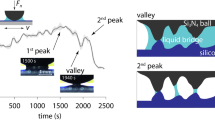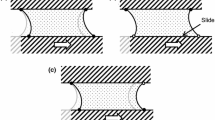Abstract
We investigated experimentally the effects of surface roughness on liquid transfer due to breakage of the liquid meniscus bridge. A liquid meniscus bridge was formed between a hemispherical glass surface (radius of curvature R = 10 mm) and a glass plate. The liquids used as test sample were ethylene glycol and n-tetradecane. The contact angles at the two solid interfaces were set the same by coating the surfaces with an oil repellent to mitigate the contact angle effects. More liquid was found to be transferred to the rougher surface, despite the contact angles being nearly the same. This phenomenon cannot be explained by the theory for smooth surfaces because the theory predicts about a 50 % transfer. Furthermore, on measuring the force curve we found that the attractive meniscus force increases as surface roughness increases. We suggested that these experimental results arise from the difference in surface roughness of the two solids.











Similar content being viewed by others
References
Ambekar RP, Bogy DB (2005) Effect of slider lubricant pickup on stability at the head-disk interface. IEEE Trans Magn 41:3028–3030
Ambekar RP, Bogy DB, Dai Q, Marchon B (2008) Critical clearance and lubricant instability at the head-disk interface of a disk drive. Appl Phys Lett 92:033104
Ambekar RP, Bogy DB, Floyd WS Jr, Bhatia CS (2009) Lubricant depletion and disk-to-head lubricant transfer at the head-disk interface in hard disk drives. J Tribol 131:031901
Bhushan B (1999) Handbook of micro/nano tribology, 2nd edn. CRC Press, Boca Raton
Chen L, Chen G, Chang J (2015a) An insight to high humidity-caused friction modulation of brake by numerical modeling of dynamic meniscus under shearing. Lubricants 3:437–446. doi:10.3390/lubricants3020437
Chen H, Tang T, Amirfazli A (2015b) Effect of contact angle hysteresis on breakage of a liquid bridge. Eur Phys J Spec Top 224:277–288
de Gennes PG, Brochard-Wyart F, Quere D (2004) Capillary and wetting phenomena: drops, bubbles, pearls, waves. Springer, New York
Derjaguin BV, Muller VM, Toporov YP (1975) Effect of contact deformations on the adhesion of particles. J Colloid Interface Sci 53:314–326
Gao C, Tian X, Bhushan B (1995) A meniscus model for optimization of texturing and liquid lubrication of magnetic thin- film rigid disks. Tribol Trans 38:201–212
Israelachvili JN (1972) The calculation of van der Waals dispersion forces between macroscopic bodies. Proc R Soc Lond Ser A 331:39–55
Israelachvili JN (1992) Intermolecular and surface forces, 2nd edn. Academic Press, New York
Johnson RE, Detter RH (1964a) Contact angle hysteresis I. Study of an idealized rough surface. Adv Chem 43:112–136
Johnson RE, Detter RH (1964b) Contact angle hysteresis II. Contact angle measurements on rough surface. Adv Chem 43:137–144
Johnson KL, Kendall K, Roberts AD (1971) Surface energy and the contact of elastic solids. Proc R Soc Lond Ser A 324:301–313
Lifshitz EM (1956) The theory of molecular attractive forces between solids. Sov Phys JETP 2:73–83
Matsuoka H, Fukui S, Morishita H (2002a) Dynamics of liquid meniscus bridge of intermittent contact slider. IEEE Trans Magn 38:2135–2137
Matsuoka H, Kato T, Fukui S (2002b) Nanomeniscus forces in undersaturated vapors: observable limit of macroscopic characteristics. Langmuir 18:6796–6801
Matsuoka H, Matsumoto S, Fukui S (2005a) Dynamic meniscus models for MEMS elements. Microsyst Technol 11:1132–1137
Matsuoka H, Ohkubo S, Fukui S (2005b) Corrected expression of the van der Waals pressure for multilayered system with application to analyses of static characteristics of flying head sliders with an ultrasmall spacing. Microsyst Technol 11:824–829
Matsuoka H, Kan-nen M, Fukui S (2011) Theoretical model for lubricant pick-up (breakage of liquid meniscus bridge due to elongation in bridged direction). IEEE Trans Magn 47:3582–3585
Matsuoka H, Kan-nen M, Fukui S (2012a) Lubricant transfer caused by breakage of liquid meniscus bridge. Microsyst Technol 18:1607–1613
Matsuoka H, Matsuda K, Fukui S (2012b) Theoretical model for lubricant pickup considering disjoining pressure of nanometer thick film. IEEE Trans Magn 48:4257–4260
Matsuoka H, Kitahama N, Tanaka T, Fukui S (2014) Theoretical study of van der Waals dispersion pressures considering one-dimensional material distributions in the in-plane direction. Microsyst Technol 20:1397–1403
Maugis D (1992) Adhesion of spheres: the JKR-DMT transition using a Dugdale model. J Colloid Interface Sci 150:243–269
Ninham BW, Parsegian VA (1970) van der Waals forces across triple-layer films. J Chem Phys 52:4578–4587
Orr FM, Scriven LE, Rivas AP (1975) Pendular rings between solids: meniscus properties and capillary force. J Fluid Mech 67:723–742
Prieve DC, Russel WB (1988) Simplified predictions of Hamaker constants from Lifshitz theory. J Colloid Interface Sci 125:1–13
Son SW, Ha MY, Kim SS, Yoon HS, Son C (2014) A numerical study on the behavior of the water meniscus formed between a flat surface and a flat or circular tip. J Mech Sci Technol 28:1285–1295
Tabor D (1977) Surface forces and surface interactions. J Colloid Interface Sci 58:2–13
Tabor D, Winterton RHS (1969) The direct measurement of normal and retarded van der Waals forces. Proc R Soc Lond Ser A 312:435–450
Tani H, Kubota M, Tsujiguchi Y, Tagawa N (2011) Visualization of lubricant pickup phenomena by lubricant thickness mapping on slider surface. Microsyst Technol 17:1175–1178
Zhao Q, Zhao Z, Lee S, Kazazic E, Embree M, Lam T, Chang S (2002) Quantitative study of lubricant puddling at the head/disk interface. Microsyst Technol 8:297–303
Acknowledgments
The authors thank Daichi Kondo and Ryo Shinohara (graduate students of Tottori University) for their assistance with data acquisition and drawings.
Author information
Authors and Affiliations
Corresponding author
Rights and permissions
About this article
Cite this article
Matsuoka, H., Miyamoto, M. & Fukui, S. Effects of surface roughness on characteristics of liquid transfer due to breakage of liquid meniscus bridge. Microsyst Technol 22, 1397–1404 (2016). https://doi.org/10.1007/s00542-016-2867-6
Received:
Accepted:
Published:
Issue Date:
DOI: https://doi.org/10.1007/s00542-016-2867-6




